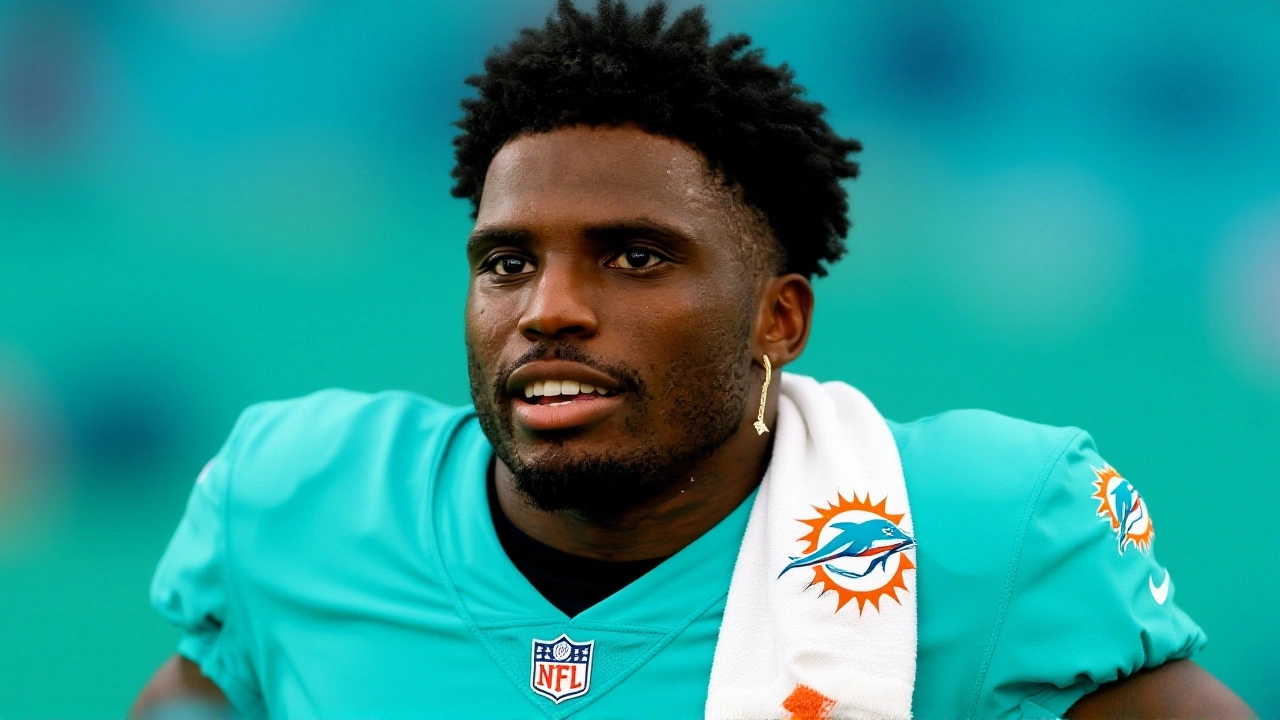When Tyreek Hill, wide receiver of the Miami Dolphins went down in the third quarter of the September 29, 2025 win over the New York Jets, the stadium fell silent. The 31‑year‑old’s knee snapped into an unnatural angle after a hit by Jets defensive back Malachi Moore, and medical staff confirmed a dislocated knee with multiple torn ligaments, including the ACL. The diagnosis, relayed by NFL Network insider Ian Rapoport on September 30, means Hill’s 2025 campaign ends after just four games.
What Happened on the Field
The game, held at Hard Rock Stadium, was a tight 27‑20 victory for Miami. Hill, who had already tallied 252 receiving yards and three touchdowns in the first four weeks, was running a slant route near the sideline when Moore drove his shoulder into Hill’s torso. The collision sent Hill sprawling, his leg twisting in a way that looked more like a gymnastics tumble than a football tackle.
Paramedics rushed onto the field, but it was clear the injury was serious. Hill was helped to a cart, his leg still locked at an odd angle, and escorted off the field under a cascade of concerned murmurs from teammates and fans alike. The Dolphins’ medical team immediately ordered imaging at a nearby hospital, where MRI scans revealed a torn ACL, torn MCL, and a ruptured meniscus.
How the Injury Was Diagnosed
According to the team’s orthopedic surgeon, Dr. Luis Ramirez, the MRI showed “a complete disruption of the anterior cruciate ligament, coupled with a grade‑III tear of the medial collateral ligament and a complex meniscal tear.” Those injuries are among the most severe in the NFL, often requiring reconstructive surgery followed by a nine‑to‑12‑month rehab program.
Hill will undergo arthroscopic surgery on Tuesday, September 30, at Miami’s Jackson Memorial Hospital. The procedure will involve grafting a tendon—most likely from his own hamstring—to replace the damaged ACL, while repairing the MCL and meniscus in a single session.
Impact on the Dolphins' Season
“Losing Tyreek is a massive blow,” said Dolphins head coach Mike McDaniel in a post‑game press conference. “He’s the guy who stretches the field, forces defenses to pick their poison, and creates space for everybody else. We’ll have to adjust, but our guys are resilient.”
Hill’s 2024 season saw 1,197 receiving yards and nine touchdowns, and he entered 2025 as the centerpiece of Miami’s high‑tempo aerial attack. In the first four games this year, he recorded 252 yards on 21 catches, averaging 12.0 yards per reception—numbers that underscore his role as a deep‑threat weapon.
The Dolphins, currently 3‑1, now face a dilemma: rely more heavily on the emerging partnership between quarterback Tua Tagovailoa and slot receiver Jaylen Waddle, or look to the depth chart for a replacement. The team’s next opponent, the Buffalo Bills, will test Miami’s ability to score without Hill’s speed.
Recovery Timeline and What Lies Ahead
Standard ACL recovery expects a return to full practices around the 9‑month mark, meaning Hill is unlikely to see action until the 2026 season. “We’ll start gentle range‑of‑motion exercises within two weeks, then progress to strength training by month three,” Dr. Ramirez explained. “The key is not to rush; re‑injury is a real risk.”
Hill’s contract, signed in 2023 for three years at $72 million, includes a guaranteed base salary for 2025, so his financial situation is secure during rehab. However, the injury could influence future contract negotiations, especially if his performance post‑rehab is limited.
Tyreek Hill’s Career and Past Injuries
Since entering the league in 2016, Hill has built a reputation as one of the NFL’s most explosive playmakers. After a late‑season ankle sprain in 2018 that cost him a playoff run, he bounced back to post back‑to‑back 1,000‑yard seasons in 2020‑2021. The 2022 season saw a minor hamstring strain, but it never kept him off the field for more than a week.
Experts note that while Hill’s style—bursting off the line, cutting at high speed—does expose him to higher injury risk, his dedication to conditioning has kept major injuries at bay until now. Sports physiologist Dr. Maya Patel commented, “His muscular balance and flexibility are top‑tier. The current injury is more a function of the impact force than any underlying weakness.”
Looking Forward: What This Means for Miami and the NFL
The Dolphins’ front office will have to decide whether to sign a veteran receiver in free agency or promote a practice‑squad player. The decision could shape Miami’s offensive identity for the next two seasons, especially with the league trending toward spread offenses that favor deep threats.
For the NFL at large, Hill’s injury adds to a growing list of high‑profile ACL tears, prompting discussions about player safety protocols and the potential for rule changes to protect vulnerable joints.
Frequently Asked Questions
How will Tyreek Hill's injury affect the Dolphins' playoff chances?
Losing their primary deep‑threat receiver removes a key weapon that stretches defenses. While Miami remains 3‑1, they will need to rely more on short‑pass routes and the running game. If the team can adapt quickly, a playoff berth is still plausible, but the odds drop compared to a full‑health roster.
What is the typical recovery timeline for an ACL reconstruction in the NFL?
Most players return to practice between eight and ten months post‑surgery, with full game action often not until nine to twelve months. Conditioning, strength, and football‑specific drills dictate the exact timeline, and setbacks can extend it.
Who will likely fill the void left by Hill in Miami's offense?
The Dolphins could elevate slot receiver Jaylen Waddle, add depth player Jaylen Samuels, or explore a free‑agency signing. Coach McDaniel hinted at giving more snaps to rookie Jameson Williams, though his experience is limited.
Has Tyreek Hill faced similar injuries before?
Hill has had ankle sprains and a minor hamstring strain, but nothing as severe as a multi‑ligament knee tear. This is his first ACL injury, making the rehabilitation process a new challenge for the veteran.
What does this injury mean for Hill’s contract and future earnings?
His contract guarantees his 2025 salary, so financially he's protected for the season. However, his market value could be impacted if his post‑rehab performance drops, potentially influencing negotiations for his 2026 extension.


